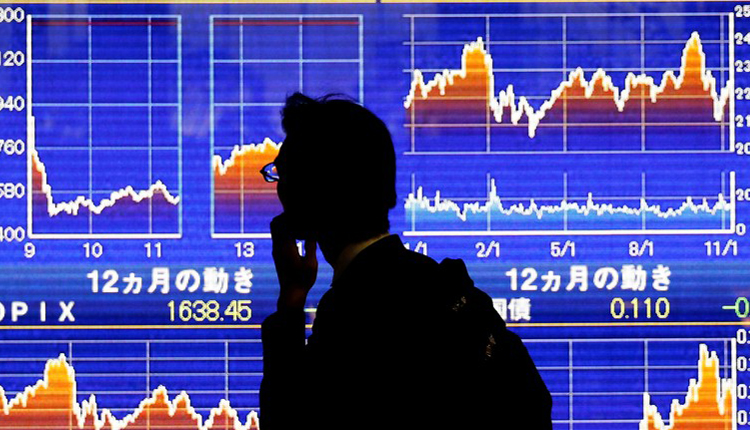Asian markets climbed on Friday ahead of U.S. nonfarm payrolls data for November expected to be released later in the day stateside.
Mainland Chinese stocks were higher on the day, with the Shenzhen component adding 0.81 percent to 9,878.62 and the Shenzhen composite also advancing 0.821 percent to about 1,640.33. The Shanghai composite rose 0.43 percent to around 2,912.01.
Hong Kong’s Hang Seng index rose 1.07 percent to close at 26,498.37, with shares of Chinese tech juggernauts Alibaba and Tencent jumping 2.65 percent and 1.7 percent, respectively.
The Nikkei 225 in Japan rose 0.23 percent to close at 23,354.40, while the Topix index ended its trading day 0.11 percent higher at 1,713.36.
Data released Friday showed October household expenditure in Japan dropping 5.1 percent year-on-year in real terms, following a sales tax hike that took place in that month.
In South Korea, the Kospi added 1.02 percent to close at 2,081.85 as shares of industry heavyweight Samsung Electronics and chipmaker SK Hynix jumped 1.82 percent and 2.28 percent, respectively.
Meanwhile, shares in Australia edged higher on the day, as the S&P/ASX 200 rose 0.36 percent to 6,707.00.
Overall, the MSCI Asia ex-Japan index was 0.56 percent higher.
Overnight stateside, stocks ended the session on Wall Street little changed. The Dow Jones Industrial Average gained just 28.01 points to 27,677.79 while the S&P 500 added 0.16 percent to 3,117.43. The Nasdaq Composite gained less than 0.1 percent to 8,570.70.
Investors awaited the release of the U.S. government’s monthly nonfarm payrolls report expected on Friday stateside. That would come following a disappointing private payrolls number released Wednesday, and also on the back of the Labor Department saying Thursday that U.S. weekly jobless claims dropped 203,000 last week — the lowest in seven months.
“With the (U.S. Federal Reserve) pretty much having exhausted its ‘insurance cuts’ and markets almost unanimously expecting the Fed to be on a purposeful pause, it is safe to say that U.S. nonfarm payroll will be relegated to the backseat,” Vishnu Varathan, head of economics and strategy at Mizuho Bank wrote in a note.
“Instead the obsession will be with tariff rollback!” Varathan said. “Specifically, whether or not White House trade negotiators will relent to offer China tariff rollback, which appears to have been established as Beijing’s precondition to strike a phase-one trade deal.”
Reuters reported Friday that China’s finance ministry said the country will waive import tariffs for certain soybean and pork shipments from the U.S., without providing further detail.
Markets have seen a rocky start to December amid conflicting headlines on the U.S.-China trade front ahead of a closely watched date of December 15 when additional tariffs on Chinese exports to the U.S. go into effect.
The Wall Street Journal reported Thursday that Washington and Beijing are still in disagreement over the size of China’s agriculture purchases. Meanwhile, China has given little indication on how negotiations with the U.S. are progressing.
Earlier in the week, markets were sent into a frenzy after U.S. President Donald Trump said he may delay a trade deal with China till after the 2020 U.S. presidential election.
“I think the markets are taking consolation that at least this is not escalating and trade talks have not broken down, talks are still going on and there’s still hope,” Vasu Menon, executive director of investment strategy at Singapore’s OCBC Bank told CNBC’s “Street Signs” on Friday.
Still, Menon acknowledged that “clearly there are disagreements” between the two economic powerhouses, be it the U.S. demands for China to purchase more U.S. agricultural products or Beijing’s desire to see Washington roll back tariffs.
Currencies and oil
The U.S. dollar index, which tracks the greenback against a basket of its peers, was last at 97.374 after slipping from levels above 98.0 earlier in the trading week.
The Japanese yen traded at 108.64 per dollar after strengthening from levels above 108.8 yesterday. The Australian dollar changed hands at $0.6842 after rising from levels below $0.678 earlier in the week.
Oil prices were largely unchanged in the afternoon of Asian trading hours, with international benchmark Brent crude futures hovering around the flatline at $63.40 per barrel. U.S. crude futures was largely flat at $58.42 per barrel.
Source: CNBC



